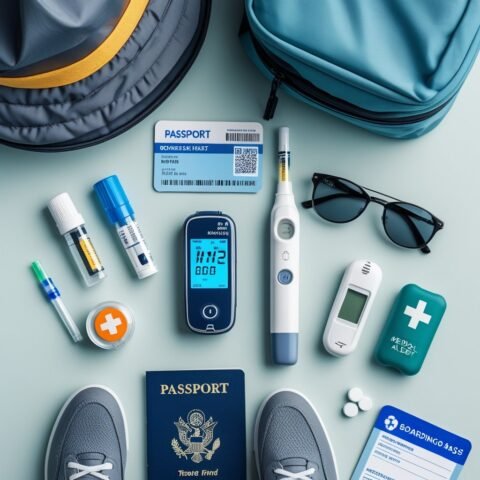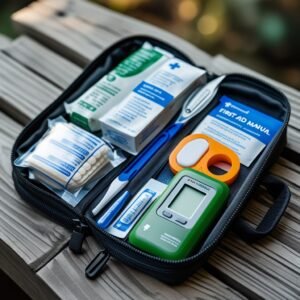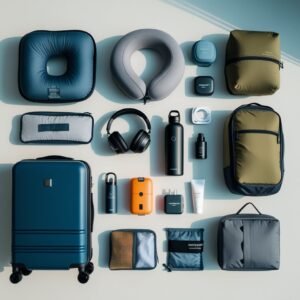Traveling with diabetes requires thoughtful preparation to ensure health and safety while away from home. Managing blood sugar levels during trips demands careful planning and packing essential supplies that might not be readily available at all destinations.
Proper preparation for diabetes management while traveling includes packing adequate medication, monitoring equipment, and having a plan for emergencies. This includes bringing extra insulin, test strips, glucose tablets, and medical identification that clearly states the traveler has diabetes.
Many travelers with diabetes worry about maintaining their routine during vacations or business trips. However, with a comprehensive checklist of diabetes essentials and proper pre-travel consultation with healthcare providers, people with diabetes can enjoy stress-free travel experiences while keeping their condition well-managed.
Diabetes Travel Essentials
Traveling with diabetes requires careful planning and packing the right supplies to manage blood glucose effectively while away from home. Preparation is key to preventing complications and ensuring a safe, enjoyable trip.
Medications and Insulin Storage
Diabetic travelers should pack twice the amount of insulin and medications normally needed for their trip duration. This precaution helps in case of unexpected delays or medication loss.
Always carry medications in original packaging with prescription labels to avoid issues at security checkpoints. These labels provide necessary information about the medication and prove it belongs to you.
Insulin must be kept at appropriate temperatures (36-46°F/2-8°C for unused vials and pens). Specialized cooling cases like Frio pouches or insulated medication bags help maintain proper temperature without refrigeration for several days.
Never store insulin in checked baggage, as cargo holds can experience extreme temperatures that damage medication. Always keep it in carry-on luggage where temperature is regulated.
Consider time zone changes when planning medication schedules. Consult with healthcare providers about adjusting insulin timing when crossing multiple time zones to prevent dosing errors.
Glucose Monitoring Tools
Pack extra glucose testing supplies, including:
- Blood glucose meter with backup batteries
- Test strips (double the expected amount)
- Lancets and lancing device
- Sensor supplies if using continuous glucose monitoring (CGM)
- Alcohol swabs for sanitation
Keep monitoring supplies easily accessible during travel, particularly during flights when glucose levels may fluctuate due to schedule changes and stress.
CGM users should research connectivity requirements in foreign countries. Some systems require smartphone connections that may be affected by international travel or different cellular networks.
Consider alternative testing methods as backup if your primary method fails. Having multiple options ensures you can continue monitoring regardless of equipment failures.
Remember that extreme climates can affect test strip accuracy and meter function. Store these items at room temperature when possible to maintain reliability.
Emergency Medical Supplies
Carry a clearly labeled diabetes emergency kit containing glucagon for severe hypoglycemia. Ensure traveling companions know where it’s located and how to administer it if necessary.
Include a medical ID card or bracelet listing your condition, medications, healthcare provider contact information, and emergency contacts. Translate this information into local languages when traveling internationally.
Bring a doctor’s letter describing your medical condition and necessary supplies. This document proves medical necessity for carrying sharps and liquids through security checkpoints.
Keep contact information for local hospitals and clinics at your destination. Research diabetes care resources before arriving, especially when traveling to remote locations.
Pack ketone testing supplies, particularly for those with Type 1 diabetes. Testing for ketones is essential when blood sugar is persistently high or during illness while traveling.
Snacks and Hypoglycemia Management
Stock fast-acting carbohydrates for treating low blood sugar:
- Glucose tablets or gel (15g portions)
- Small juice boxes
- Hard candies
- Dried fruit
These items should be easily accessible in carry-on luggage, day bags, and pockets during activities.
Pack longer-lasting snacks containing protein and complex carbohydrates to maintain stable blood sugar during travel delays. Options include nuts, cheese sticks, and whole grain crackers.
Research food availability at your destination and during transit. Some locations may have limited options for appropriate meals, making pre-packed snacks essential.
Consider portable measuring tools to estimate carbohydrate content when eating unfamiliar foods abroad. Food scales or reference charts can help maintain accurate carbohydrate counting while traveling.
Learn key phrases related to diabetes and food in the local language when traveling internationally. Being able to communicate dietary needs can prevent dangerous blood sugar fluctuations.






